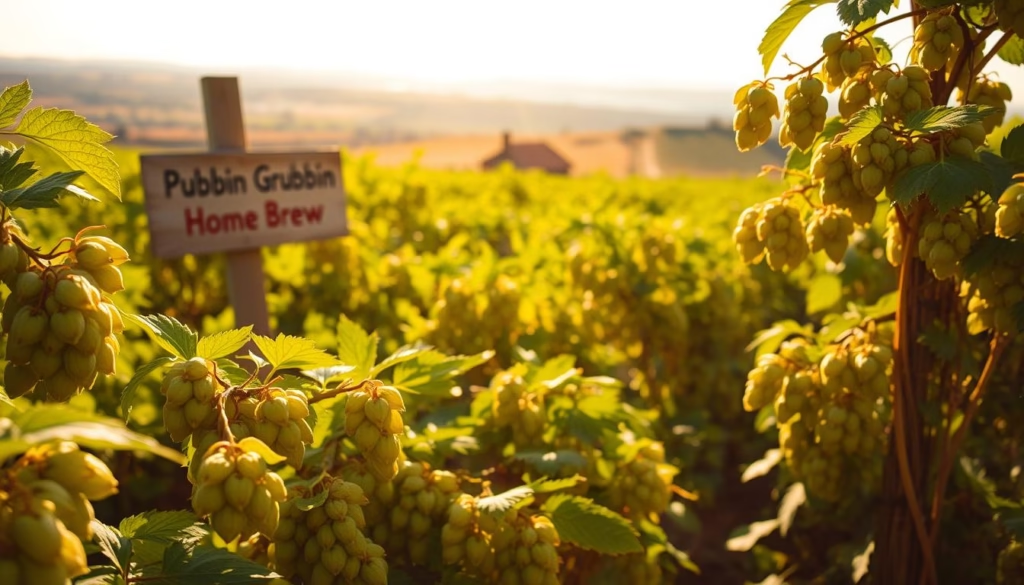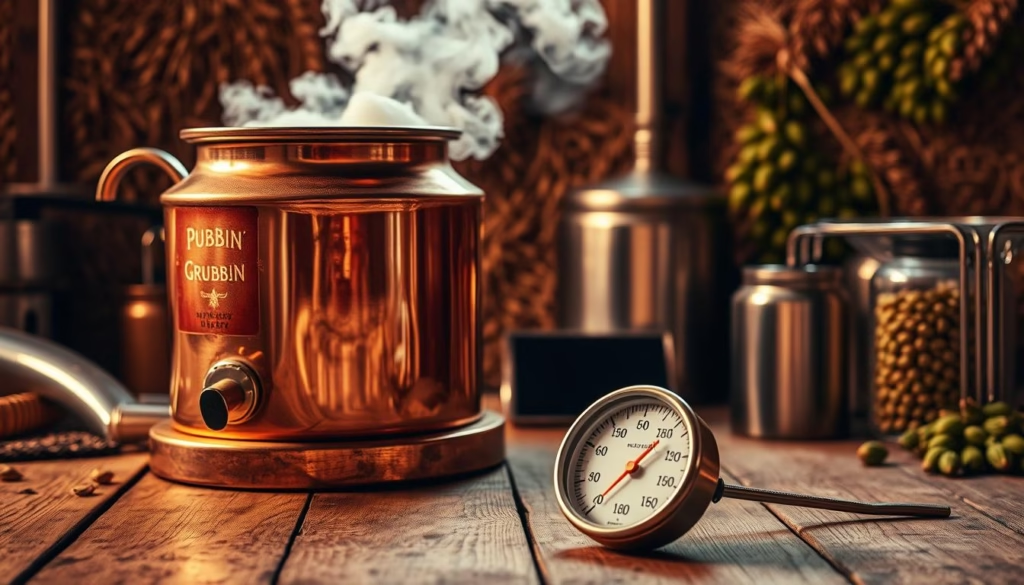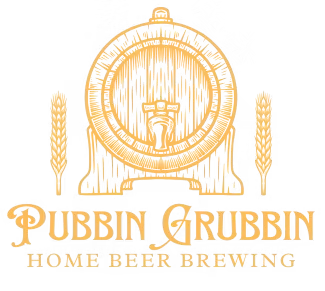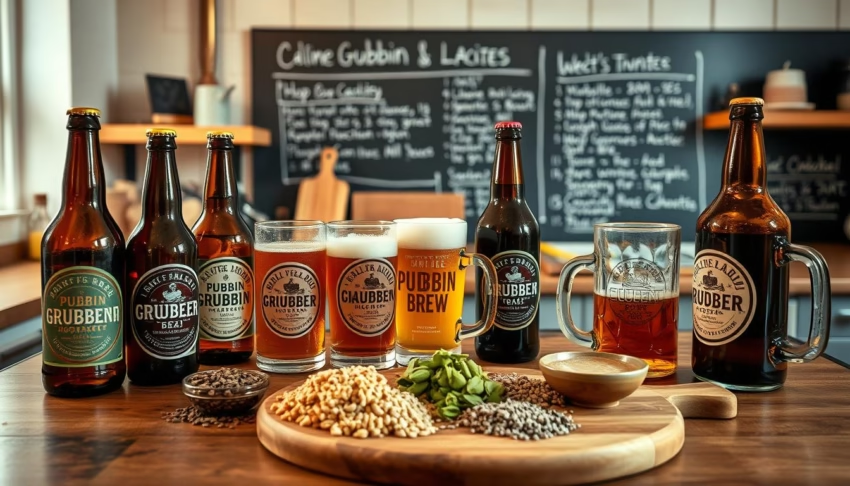There are moments when a single sip can bring back a memory—warm kitchens, late-night experiments, the quiet thrill of a recipe that finally clicks.
I started brewing because I wanted that exact feeling: to chase flavor and learn the why behind each pour. This guide collects standout clones and originals—from a bold IPA like Pliny the Elder to a balanced Sierra Nevada pale—so you can pick by style and strength with confidence.
Inside you’ll find exact batch sizes and lab-style stats—OG, FG, ABV, IBUs—paired with clear notes on aroma, hop signatures, grain backbones, and yeast choices. That means you see the building blocks of a profile before you brew.
The pages that follow bridge beginner extract paths and all-grain technique. You’ll get mash basics, whirlpool tips, dry-hop timing, and simple scaling notes to make results repeatable.
Key Takeaways
- Find curated clones and originals with precise batch stats to match your taste.
- Learn sensory profiles so you can target the flavor and aroma you want.
- See essential ingredients—grains, hops, yeast—and why they matter.
- Follow clear process keys to turn recipes into consistent results.
- Scale recipes and track OG/FG for better batch-to-batch control.
Kick off brew day: how to use this list of beer recipes for fast wins
A smooth brew day starts with a plan—pick a clear path and set timers before you heat the kettle.
Decide extract or steeping first. For extract, bring about three gallons to a rolling boil, then add liquid malt extract off heat to avoid scorching. Resume the boil and follow hop additions at 60, 15, and 5 minutes.
If you use steeping grains, hold them at 150–160°F for 20 minutes, remove the bag, then bring the wort to a full boil and add hops per schedule.
- Confirm the exact amount of fermentables and hop varieties before you start.
- Prep chill gear so you can cool quickly after the wort boil to protect aroma.
- Use a checklist: sanitize, measure, heat, add extract, follow hop minutes, chill, transfer, pitch.
| Method | Pre-boil Volume | Key Steps |
|---|---|---|
| Partial extract | ~3 gallons | Add extract off heat; boil 60 min with hop schedule |
| Steep grains | 2–3 gallons | 150–160°F for 20 minutes; remove grain; proceed to boil |
| All-grain (note) | Varies | Full mash, monitor mash temps and boil timing |
Record start and end times, volumes, and temperatures in your brew log. Small notes on kettle heat and transfer minimize oxygen and speed repeatable creation.
Top home brewed craft beer recipes to try now
Start with a shortlist of standout formulas to match the flavor and intensity you want.
Avg. Perfect New England IPA — hazy, soft bitterness
Size: 5.75 gal • OG 1.062 • FG 1.013 • ~6.5% abv • 59.26 IBUs.
Pastel haze and juicy aroma define this new england ipa. It offers gentle bitterness and plush mouthfeel so you can highlight late hops and dry-hop aroma.
Sierra Nevada Pale Ale clone — balanced citrus-pine
Size: 6.5 gal • OG 1.055 • FG 1.013 • ~5.58% abv • 39.79 IBUs.
Classic citrus and resin notes. This style is forgiving and great when you want a crowd-pleasing profile with measured bitterness.
Zombie Dust clone — Citra-forward IPA (all-grain & extract)
All-grain: 6 gal, OG 1.061, FG 1.016, ~5.94% abv, 62.42 IBUs. Extract: 5 gal, OG 1.063, FG 1.016, ~6.16% abv, 70.18 IBUs.
Choose the amount and method that fits your setup. Both paths emphasize Citra hop character and bright bitterness.
Pliny the Elder (original) — iconic Imperial IPA
Size: 6 gal • OG 1.072 • FG 1.018 • ~7.09% abv • 232.89 IBUs.
This one explains why hop load matters — intense bitterness and a clean finish for experienced brewers chasing a West Coast benchmark.
- Quick pick: NEIPA and Pale Ale are forgiving; Pliny tests your process.
- Each listing gives gravity and batch targets so you can match expected amount and attenuation.
Beginner-friendly extract beer recipes for your first wort boil
For a first wort boil, pick a simple extract plan and focus on timing, not gadgets.
Easy Extract Blonde Ale
Simple, clean, citrus-touched
Size: standard 5–6 gallon fermenter. Use 6.6 lb Pilsen LME. Add 1 oz Amarillo at 30 minutes. Add Whirlfloc at 15 minutes to clear the wort. Pitch Safale S-04 when cooled.
Easy Extract Amber Ale
Caramel depth with rounded hops
Use 6.6 lb Amber LME and steep 1 lb Caramel 40L. Add 1 oz Willamette at the 60-minute mark for bittering, then 1 oz in the whirlpool for aroma. Ferment with WLP060.
Easy Extract IPA
Layered hop clarity without complex gear
Combine 6.6 lb Light LME + 1 lb Light DME. Steep 1 lb Crystal 20L. Add 1 oz Citra at 60 minutes, 1 oz Amarillo at 10 minutes, and 1 oz Cascade in the whirlpool. Use US-05 for a clean finish.
“Bring the wort to a steady boil, then follow the minute schedule — timing shapes flavor.”
- Practical tips: keep malt additions off direct heat to avoid scorching. Track size and top-up water to hit the amount you want in the fermenter.
- These extract beer recipes minimize gear—steep grains if noted, boil, and add hops by minutes for repeatable results.
- Cool the wort in an ice bath if you lack a chiller; aim for proper pitch temps before transferring.
All-grain favorites that level up your homebrewing
Move to all-grain to learn how grain choice and mash temp shape every sip.
Tank 7 clone (Saison) — 5.5 gal, OG 1.073, FG 1.015, ~7.63% abv, 41.11 IBUs.
Tank 7 leans dry and peppery. Keep mash temps low to boost attenuation and let the saison yeast shine. Watch oxygen and pitch a healthy amount of yeast for steady fermentation.
Pilsner Urquell BYO clone
11 gal, OG 1.051, FG 1.013, ~4.92% abv, 36.45 IBUs.
Soft water and a vigorous boil matter here. Use a delicate hop hand and a lower mash temp for a crisp finish. Track evaporation so the final gravity and amount match your target.
Bells Two Hearted clone
5.5 gal, OG 1.073, FG 1.018, ~7.14% abv, 63.62 IBUs.
This one teaches single-hop focus. Use Centennial and dial the timing to highlight grapefruit and pine without extra harshness.
- Grain and mash: adjust mash schedule to target body—lower for drier styles, higher for fuller mouthfeel.
- Boil and hops: match boil vigor to batch size and monitor hop amounts to hit bitterness goals.
- Yeast and process: pitch right, oxygenate, and track temps for consistent ABV and clean profiles.
Comfort sips: cream ales, porters, and seasonal standouts
Comfort styles focus on balance: restrained hops, clear malt character, and aroma that invites another sip.
Vanilla Cream Ale & Spotted Clown-inspired cream ale
Vanilla Cream Ale: 5.75 gal • OG 1.055 • FG 1.013 • ~5.48% abv • 19.44 IBUs.
Spotted Clown (Spotted Cow-inspired): 5.5 gal • OG 1.054 • FG 1.014 • ~5.36% abv • 21.27 IBUs.
Cream ales offer subtle grain sweetness and very clean fermentation. Keep hop additions light and focus on carbonation and crisp flavor.
Chocolate Vanilla Porter
6 gal • OG 1.060 • FG 1.016 • ~5.77% abv • 31.36 IBUs.
The porter layers roasted malt with dark chocolate and gentle vanilla. Control the boil and time late additions so aroma stays bright without harsh extraction.
Pumking-inspired spiced ale
5.5 gal • OG 1.083 • FG 1.021 • ~8.16% abv • 50.22 IBUs.
This spiced ale is autumn in a glass—measure pumpkin and spice carefully. Let the malt base carry warmth; add spices in stages to tune the final flavor.
- Size and amount matter: stick to target volumes to hit OG and abv goals.
- Use moderate IBUs and restrained hops to keep flavor integrated and emphasize aroma.
- Treat vanilla gently—post-fermentation dosing or tinctures give precise control.
- Watch boil vigor so delicate aromas survive while you still get a good hot break.
“Balance and restraint are your allies when making comforting, flavorful ales.”
Home brewed craft beer recipes for hop lovers
When you want punchy aroma without harshness, focus on where and when you add hops.

Racer 5 IPA clone: firm bitterness, citrus-pine profile
Size: 5.5 gal • OG 1.073 • FG 1.019 • ~7.07% abv • 73.63 IBUs.
Racer 5 emphasizes firm bitterness and classic citrus-pine flavor. Time your boil additions precisely and consider a late add hops charge for brightness.
White IPA: wheat-meets-IPA hybrid for a zesty finish
Size: 10 gal • OG 1.064 • FG 1.017 • ~6.2% abv • 55.96 IBUs.
Wheat softens body and lets IPA hops sing. Balance protein haze with a clean fermentation for a zesty, refreshing finish.
Mango Habanero IPA: sweet heat in an Imperial IPA frame
Size: 5.5 gal • OG 1.086 • FG 1.018 • ~8.88% abv • 98.09 IBUs.
Mango Habanero pairs fruit sweetness with pepper heat. Control capsicum extraction—add peppers late and dose fruit to keep flavor integrated.
- Respect batch size and amount: follow hop weights to hit IBUs without harshness.
- Oxygen control after fermentation preserves hop aroma and flavor—avoid splashing on transfers.
- Use whirlpool and dry-hop techniques to push bitterness toward hop flavor; adjust boil timing if perceived bitterness runs high.
What goes into a great beer recipe: grain, hops, yeast, water
Great formulas start with clear choices about grain, hops, yeast, and water—each one nudges flavor in a predictable direction.
Grain bill and mash
Build from the base up: use 60–65% base malt (2-row or Pilsner), add ~30% flaked oats or wheat for body, and 5–10% dextrin malt for residual sugar and mouthfeel.
Match mash degrees to the outcome—lower temps for drier finish, higher temps for fullness. Track mash pH for enzyme efficiency.
Hops strategy
Plan hop phases: brief bittering at the boil for backbone, a large whirlpool charge at ~180°F for 20 minutes for flavor, then 3–6 oz dry hop per 5 gal for aroma and juiciness.
Yeast and fermentation
Choose a strain that adds character—English ale strains like Wyeast 1318 or Imperial A38 give fruity esters and fit 6–7% ABV targets.
Water profile
Dial minerals: aim near 200 ppm chloride, 100 ppm sulfate, and ~100 ppm calcium for a soft, thick mouthfeel. Use a water calculator to validate adjustments.
- Kettle workflow: consistent heat, timed additions, and careful notes ensure repeatable results.
- Keep total hop load reasonable to protect yield and avoid vegetal extraction.
Dialing in NEIPA: ingredients, wort boil, and zero-oxygen practices
Think of a New England IPA as a layered painting—grain builds the canvas, hops add color, yeast blends tones.
Base grain target
65% base malt, 30% oats/wheat, 5% dextrin gives that pillowy body and gentle residual sugar for a soft finish. This grain mix holds haze and boosts mouthfeel without heaviness.
Hops and yeast
Lean on cheater hop combos—Citra, Galaxy, Mosaic, or Nelson—for saturated tropical and citrus aroma. Reserve most flavor for post-boil moves and dry-hop.
Pick English ale yeast like Wyeast 1318 or Imperial A38 for fruity esters and moderate attenuation. They keep body and let hop aroma sing.
Water, whirlpool, and oxygen control
Target a 2:1 chloride to sulfate water profile (about 200 ppm Cl / 100 ppm SO4) for a plush mouthfeel and soft bitterness. Hold whirlpool at ~180 degrees for ~20 minutes, then soft crash to ~58°F before dry hopping.
Zero-oxygen handling during dry-hop and transfers preserves hop oils and prevents oxidation.
| Item | Target | Why it matters |
|---|---|---|
| Grain | 65/30/5 | Body, haze, controlled residual sugar |
| Whirlpool | 180°F / 20 min | Flavor extraction without vegetal notes |
| Water profile | ~200 Cl / 100 SO4 | Plush mouthfeel; soft bitterness |
| Yeast | Wyeast 1318 / A38 | Fruity esters, balanced attenuation |
Process that matters: mash temps, boil times, whirlpool, and dry hop
Nailing the hot side sets the tone for a clean, repeatable batch. Start with a 154°F mash to build body and leave a touch of residual sugar. If you’re using oats or wheat, add rice hulls to keep the grain bed flowing and avoid a stuck mash.
Run a straight 60-minute boil in a vigorous kettle to sanitize and curb DMS precursors. In the last few minutes, add Whirlfloc and yeast nutrients so fermentation starts healthy.
Chill the wort to about 180 degrees, then perform a hop stand for ~20 minutes. This post-boil hold pulls oils for flavor while limiting harsh bitterness.

When you add hops after the boil, purge lines and vessels where you can to protect aroma from oxygen. Track minutes for mash rests, boil time, and hop stand so you can repeat what worked in the kettle.
Finish the hot side by soft crashing to ~58°F before dry hopping. That step limits enzymatic sugar release and hop creep. Pitch a healthy yeast starter and keep fermentation temps steady to lock in the gains from your careful process.
“Small, timed moves on the hot side make the cold side easier—and the final pour better.”
- Mash at 154°F; use rice hulls with high adjunct levels.
- Boil 60 minutes; add Whirlfloc and nutrients late.
- Hop stand at 180°F for 20 minutes; track minutes precisely.
- Soft crash to ~58°F before dry hop; purge when adding hops.
From fermenter to glass: fermentation control, hop creep, and kegging
The move from fermenter to keg is where technique meets timing — and flavor wins.
Fermentation control: keep temps at ~68–70°F for about seven days to let yeast work steadily. Consider a one-time oxygen dose at pitching for higher gravity worts or older yeast packs. A healthy start reduces off-flavors and helps hit your target profile.
Soft crash before dry-hopping. Drop to ~58°F to slow activity and limit hop creep when you add hops. That step preserves sweetness and keeps ABV stable.
Zero-oxygen dry-hop: purge hop containers, lines, and the fermenter headspace with CO2. Use a CO2-purged hop dropper or closed system to protect delicate hop oils during contact.
Keg-first packaging works best when you transfer under CO2 pressure. Pre-purge Corny kegs with sanitizer then CO2. Use a Bouncer inline filter on the fill line to trap particulates and avoid clogged dip tubes.
| Step | Target | Why it matters |
|---|---|---|
| Primary fermentation | 68–70°F / ~7 days | Consistent yeast activity; clean esters |
| Soft crash | ~58°F | Limits hop creep before dry-hop |
| Dry-hop handling | CO2 purge / closed dropper | Protects hop aroma from oxygen |
| Kegging | CO2 closed transfer + inline filter | Prevents oxygen pickup and particulate transfer |
“Small moves during transfers protect hours of careful mash and boil work.”
Premium unlock brewing: tools and techniques to upgrade your brew day
Upgrade your setup and you’ll notice the most predictable, delicious shifts in every batch.
Unlock brewing tools: RO water + salts, temperature control, hop dropper
Start with neutral water. Use RO or distilled water and add precise minerals—Calcium Chloride, Gypsum, Epsom, and a pinch of sodium chloride—to hit targets like ~200 ppm chloride / ~100 ppm sulfate for a soft NEIPA mouthfeel.
Invest in temperature controllers, spunding valves, and zero-oxygen hop droppers. These unlock brewing tools tighten fermentation control and protect hop character during transfer.
Recipe creation toolkit: BrewFather profiles, style targets, ABV and IBU planning
Model before you mix. Use BrewFather to set style ranges, ABV/IBU goals, and batch volumes. Track grains, kettle boil-off, and trub losses so your creation numbers stay true.
- Standardize efficiency and kettle loss to make scaling effortless.
- Use starters, nutrients, and measured oxygen at pitch to support yeast health.
- Plan hop timing in software, then validate with tasting notes and adjust.
“Control the inputs, and your output becomes predictable.”
Conclusion
This final note pulls together the methods and styles so you can turn a plan into a repeatable creation.
You now have a clear path from simple extract approaches to advanced all-grain and NEIPA workflows. Plan your brew day, follow measured steps—mash, boil, whirlpool, fermentation, and kegging—and record what works.
Use water profiles and ingredient choices to shape mouthfeel and bitterness. Apply zero-oxygen handling for hop-forward styles and refine technique with logs and software so each batch improves.
Whether you prefer comfort pours or big hop showcases, this guide arms you with the process to brew with confidence at home. Finish the end of your plan with care, then taste the result.
FAQ
What basic ingredients do I need to follow these recipes?
You’ll need malted grain or malt extract, hops, yeast, and clean water. For many entries here—like NEIPA or Pale Ale—add adjuncts such as oats or wheat, and consider yeast strains (e.g., Wyeast 1318 or Imperial A38) to shape aroma and esters. Salt additions and water treatment help finish mouthfeel and bitterness.
How do I decide mash temperature and time for all-grain recipes?
Target mash temps based on desired body—around 152–156°F for balanced body, 154°F for a fuller mouthfeel. Mash 60 minutes is standard; adjust by 1–2°F for drier or sweeter finish. Use rice hulls if your grist is high in oats or wheat to avoid stuck mash.
When should I add hops during the boil?
Add hops early for bittering (60 minutes), mid-boil for flavor (15–30 minutes), and late for aroma (0–5 minutes). For whirlpool or hop-stand aroma, add a large charge post-boil at about 180°F for 15–30 minutes, then chill quickly to preserve volatile oils.
How do I calculate ABV and IBU for a recipe?
Measure original gravity (OG) and final gravity (FG) to estimate ABV: (OG−FG)×131.25. Use hop alpha acids, boil time, and batch size to estimate IBUs—many brew apps like BrewFather automate these calculations and help set style targets.
What yeast choices suit juicy, hazy IPAs versus crisp lagers?
For hazy IPAs, pick English or American ale strains that accentuate fruity esters (Wyeast 1318, London Ale blends). For crisp lagers or Pilsners, use clean lager strains at low temps (48–55°F) and allow longer cold conditioning for clarity.
How do I minimize oxygen pickup during dry hopping and transfers?
Purge fermenters and kegs with CO2 before transfers, perform closed transfers where possible, and avoid splashing. Use gentle siphoning and consider CO2-pressurized dry hop methods or hop sacks to limit exposure—this reduces oxidation and preserves hop aroma.
What water profile should I aim for different styles?
Match water to style: higher chloride-to-sulfate (around 2:1) for soft, juicy NEIPAs to enhance mouthfeel; higher sulfate for hoppy, crisp IPAs to accentuate bitterness. Use RO water plus brewing salts for consistent, controllable results.
How long and at what temperature should I ferment IPAs and ales?
Most ales ferment well around 65–70°F. Aim for a primary fermentation window of about 5–10 days until activity slows, then allow a diacetyl rest if needed. Adjust temperature to influence esters—slightly warmer gives more fruity character.
What’s the recommended boil length and post-boil routine?
A 60-minute boil is standard to ensure wort stability and proper hop utilization. Add Whirlfloc or clarifiers in the last 10–15 minutes. After flameout, perform a hop stand at ~180°F for aroma, then chill rapidly to pitching temperature to lock in volatile aromas.
Can I convert extract recipes to all-grain, and how?
Yes—replace extract gravity with an equivalent grain bill using a mash efficiency estimate (typically 70–75%). Scale specialty grains the same. Adjust hop additions slightly if batch size or boil volume changes, and recalculate OG/IBU with a brewing calculator.
How do I control hop creep in dry-hopped beers?
Reduce residual enzymatic activity by cold-crashing to near fermentation temps before dry hopping, use lower dry-hop temperatures, and monitor gravity after dry hop. Avoid excessive sugar adjuncts late in fermentation that can fuel renewed fermentation from hop enzymes.
What tools upgrade my brew day for consistent results?
Invest in reliable temperature control (fermentation fridge or controller), a precise scale, good thermometer or probe, RO water system plus brewing salts, and software like BrewFather for recipe formulation and tracking. A wort chiller and pump make sanitation and timing simpler.
How do I clone commercial beers like Sierra Nevada Pale Ale or Pliny the Elder?
Study their malt profile, hop varieties, and target OG/FG. For Sierra Nevada-style pale, use a Maris Otter or pale base with Centennial and Cascade hops. For Pliny-style Imperial IPA, ramp up base malt and use multiple high-alpha hops (Citra, Centennial, Simcoe) across the boil and dry hop. Tweak water and yeast to match mouthfeel and ester profile.
What sanitation practices are essential on brew day?
Clean first, then sanitize contact surfaces with a no-rinse sanitizer like Star San. Sanitize fermenters, airlocks, siphon lines, and anything that touches cooled wort. Maintain good personal hygiene and avoid contaminating cooled wort with non-sanitized tools.
How long should I condition beer before packaging or tapping?
Conditioning time varies: many ales are drinkable after 2–3 weeks, but most benefit from 3–4 weeks for flavors to round out. Higher ABV beers and lagers need longer conditioning and cold conditioning. Carbonation time depends on packaging—bottle priming takes 2–3 weeks at room temp; kegging with CO2 can be force-carbonated faster.

